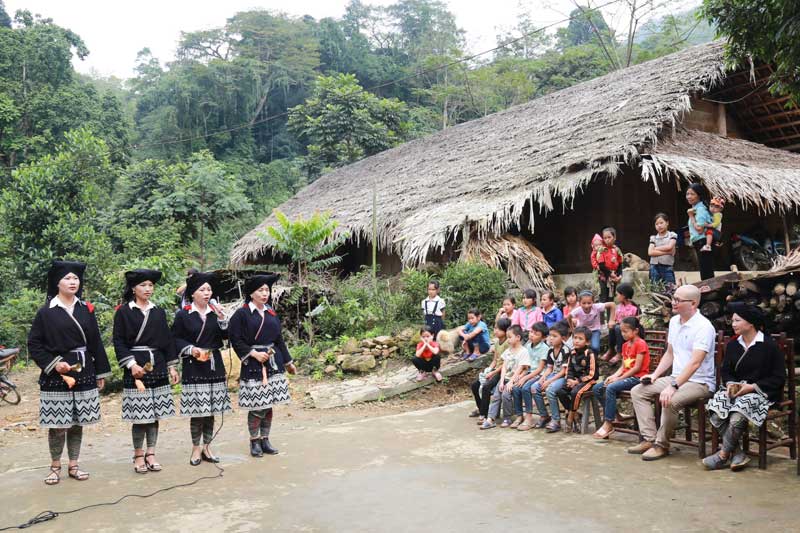
(HBO) - If Muong ethnic people have Senh Tien dance, Thai and Tay ethnic people have Xoe dance, Mong ethnic people have Khan dancing… Dao ethnic people have Chuong dance. Currently, Dao ethnic people account for 13.71% of the population in Da Bac district.
 Dao ethnic people in Sung village, Cao
Son commune (Da Bac) are performing Chuong dance to serve tourists.
Dao ethnic people in Sung village, Cao
Son commune (Da Bac) are performing Chuong dance to serve tourists.
The
distinguished artist studying the folk beliefs and culture of Dao ethnic
people, Mr. Ly Van Hien from Sung hamlet, Cao Son commune (Da Bac), says that
Chuong dance is one of the main dances and specialties in the scared rituals
and ceremonies of Dao ethnic people such as New Year of dance, Lap Tinh
ceremony, Thanh Minh New Year, the full moon of lunar January and July…
Especially, Chuong dancing during the New Year of dance is the thanksgiving
ceremony to the ancestors, Ban Vuong, who protected the life of the family and
the lineage with the hope that the ancestors will protect all members of the
family and the lineage so that they are healthy, make a good living, and help
the villagers have a prosperous and peaceful life.
As
a traditional dance of Dao ethnic people, Chuong dance usually involves both
men and women, each round of Chuong dance has 6 or more participants, the more
the funnier. When dancing, the left hand of dancer holds a dam, the right hand
holds a bell to beat the rhythm and there is a leader. While dancing, they sing
the ancient songs, simulating the process of making a living on a new land,
getting married and giving birth to children in each family.
In this dance, the
small bell made of copper with the hilt is the main props for the dancer to
hold, combined with some auxiliary props such as a small drum, a Vietnamese
two-chord fiddle, a flute ... to create rhythmic but vibrant and healthy music,
taking the footsteps of Dao boys and girls bounced and dance.
Chuong
dance is a traditional dance of Dao ethnic people. Since we were little girls and
boys, we have got in touch with the nation's Chuong dance and we were taught
and guided by our grandparents and parents. For Dao ethnic people, the cultural
beliefs and the traditional dances are deeply embedded in the blood and no one
cannot dance Chuong.
Especially, since there was community tourism in Sung
hamlet, they started welcoming international visitors, learning about the
landscape, the culture, the beliefs, and experiencing activities in cultural
activities of the daily life of the local people, Chuong dance is performed to
serve tourists visiting and traveling in the village, not just on the occasions
of the festivals, Tet or the unions of family and lineages as before. I see
that foreigners coming here like watching the traditional Chuon dance, and they
like participating directly in the stages of making brocade, drawing beeswax,
embroidering the traditional brocade ofDao ethnic group.
With an increasingly vibrant and widespread emulation movement aimed at building cultured residential areas and cultured families, Yen Thuy District has been making steady progress toward improving both the material and spiritual well-being of its people, while fostering a civilized, prosperous, beautiful, and progressive community.
Once lacking recreational spaces and community facilities, Residential Group 2 in Quynh Lam Ward (Hoa Binh City) has recently received attention for the construction of a new, spacious, and fully equipped cultural house. The project followed the model of state support combined with public contributions in both labor and funding.
The "All people unite to build cultural life" movement, which has been effectively integrated with Kim Boi district’s socio-economic development goals, is fostering a lively spirit of emulation across local residential areas, hamlets, villages, public agencies, and enterprises. In addition, through the initiative, traditional cultural values are being preserved and promoted, while community solidarity and mutual support in poverty reduction and economic development are being strengthened.
A working delegation of the Hoa Binh provincial People’s Committee led by its Permanent Vice Chairman Nguyen Van Toan on June 11 inspected the progress of a project to build the Mo Muong Cultural Heritage Conservation Space linked to tourism services in Hop Phong commune, Cao Phong district.
Born and growing in the heroic land of Muong Dong, Dinh Thi Kieu Dung, a resident in Bo town of Kim Boi district, in her childhood was nurtured by the sweet lullabies of her grandmother and mother. These melodies deeply imprinted on her soul, becoming an inseparable part of her love for her ethnic group's culture. For over 20 years, this love for her hometown has driven Dung to research, collect, and pass down the cultural values of the Muong people to future generations.
In the final days of May, the Ethnic Art Troupe of Hoa Binh Province organized performances to serve the people in remote, mountainous, and particularly disadvantaged areas within the province. These were not just ordinary artistic shows, but they were the meaningful journeys aimed at spreading cultural values, enhancing the spiritual life of the people and contributing to the preservation of ethnic minority cultural identities.



 Dao ethnic people in Sung village, Cao
Son commune (Da Bac) are performing Chuong dance to serve tourists.
Dao ethnic people in Sung village, Cao
Son commune (Da Bac) are performing Chuong dance to serve tourists.